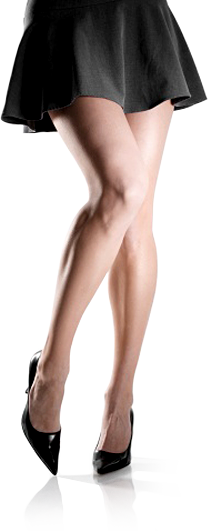Finding the best professional help for vein disease can dramatically improve your quality of life. Primary care physicians or other medical practitioners who do not specialize in the treatment of vein disease typically do not have the training and technology necessary to accurately assess vein disease. For this reason, it is highly recommended that you seek the care of a vein specialist if you have or have had any of the following conditions:
- Pain, discomfort, tiredness, or swelling in your legs and feet (common symptoms of chronic venous insufficiency, or CVI)
- Vein-related wounds (venous stasis ulcerations)
- Varicose veins
- Blood-clot complications or hemorrhaging of your leg veins
Cosmetic and Medical Benefits
Many patients with spider veins seek treatment primarily for cosmetic reasons. Unsightly spider veins can cause feelings of embarrassment and self-consciousness. Women are especially prone to hiding their legs and feet with heavy clothing during the hot, summer months to avoid revealing their spider veins in shorts, skirts, and sandals. This solution is not only uncomfortable, but it also has a negative impact on one’s quality of life.
If the unsightliness of veins in your legs and feet are limiting your lifestyle and damaging your self-esteem, then the cosmetic issue also becomes a substantial health issue. Treatments for spider and varicose veins typically provide both cosmetic and medical benefits, improving aesthetic appeal and reducing vein-related medical symptoms.
Early Intervention
Leg-vein disease is progressive and can lead to serious future problems if left untreated. Even if your symptoms are mild and non-debilitating now, you may develop an increased risk of blood-clot complications, including superficial phlebitis and the more serious deep vein thrombosis (DVT). Early intervention of leg-vein conditions can slow the progression of disease and can also reduce the number of treatments required.
Modern vein treatment techniques address the root causes of vein disease, providing comprehensive and lasting results. With advances in technology, there is no reason to postpone treatment and allow a minor cosmetic problem to grow into a major medical issue. A trained and experienced vein specialist can provide you with a thorough assessment and treatment options now so that you don’t have to worry about the consequences later.
Selecting Your Vein Specialist
Advances in vein medicine have started to become more widely known and appreciated. Because of this, there has been an increase in the number of doctors attempting to add vein treatments as one aspect of their practices. Please be aware, however, that just because vein treatment services are offered does not mean that the doctor is a specialist. When seeking professional medical care for your vein conditions, please carefully consider the experience and dedication of your physician.
Dr. William Goldstein at Midwest Vein Care has more than 20 years of experience treating varicose and spider veins and is Board Certified in Plebology – the art and science of assessing and treating vein disease. MVC utilizes state-of-the-art technology and techniques to offer surgical and non-surgical vein procedures.
We understand the importance of self-improvement and are committed to providing the safest and most effective vein and skin care treatments available in St. Louis.
Call Midwest Vein Care today
to schedule a FREE vein consultation.
636.536.0241


